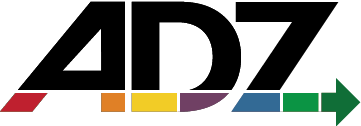Team Roles
- Values & Goals
- Committed to the product vision
- Demonstrates commitment & responsibility
- Proactively acts & communicates
- Willing to learn & grow
- Challenges the status quo if appropriate
- Customer focused
- Product & Impact
- Delivers customer value
- Ensure Quality (avoid defects)
- Healthy team metrics
- Creates reusable functionality
- Leadership & Culture
- Shares responsibility towards ToT goal
- Embodies Team Culture
- Transparent, overcommunication
- Shares best practices
- Innovation & Growth culture
- Business & tech partnership
- Markets & Environment
- Follows/Trusts the processes & standards
- Ability to network with outside systems
- Ruthlessly eliminates waste
- Balances internal & external needs
- Automation focus
The Team is the foundation of Agility. Since the early days of Agile, the focus has been on breaking down impediments to self-organization, collaborative genius, and single-piece flow of work at the team level. The breakthrough improvements seen by early adopters powered the Agile movement and led to the development of approaches for scaling these results beyond the team, across the technology enterprise and even into business value streams. Regardless of the approach or scope of an Agile transformation, success begins at the Team Holon, and depends in turn on the growth and alignment of the individual Team Members that comprise it.
Product Owner
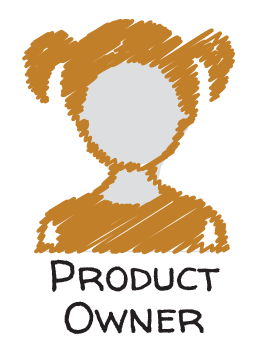 The Product Owner owns the vision for the product they are supporting. They are responsible for defining user stories, prioritizing the backlog and enabling their team to efficiently deliver value.
The Product Owner owns the vision for the product they are supporting. They are responsible for defining user stories, prioritizing the backlog and enabling their team to efficiently deliver value.
Another key responsibility of the Product Owner is accepting their team’s user stories by confirming they meet the acceptance criteria, the Definition of Done and, most importantly, the needs of their users.
In addition to internal team responsibilities, the Product Owner owns external team relationships with other POs, stakeholders, leaders, and customers.
The Product Owner does not need to be the foremost expert for their given product (though it helps), but they do need to be passionate about the product they are building. A PO who isn’t an expert can still succeed if they have good relationships with the stakeholders, SMEs, and customers they represent.
- Values & Goals
- Passionate about the product
- Result oriented
- Clearly communicates value
- Deep understanding of the market & customer needs
- Product & Impact
- Creates Backlog/User Stories
- Defines priority
- Makes Stories READY
- Creation of value
- Accept stories when done
- Leadership & Culture
- Owns the Vision
- Communicates with Stakeholders/Client
- Shares overall value with team (context)
- Markets & Environment
- Owns the process/methodology
- Product impact on system/product family
- Market impact
Technical Lead
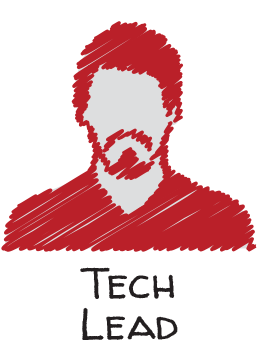 The Team Technical Lead is accountable for the integrity of the technical platform that the team is building. This includes alignment with architectural standards and ability to support the current and future functional and non-functional requirements of the product or solution the team is working on. Additionally the Technical Lead is responsible for the quality of the code produced by team members, and fostering learning and knowledge sharing within the team to ensure they are able to continue to maintain and extend the solution over time without incurring waste due to specialized knowledge, attrition, or code that is hard to read and understand.
The Team Technical Lead is accountable for the integrity of the technical platform that the team is building. This includes alignment with architectural standards and ability to support the current and future functional and non-functional requirements of the product or solution the team is working on. Additionally the Technical Lead is responsible for the quality of the code produced by team members, and fostering learning and knowledge sharing within the team to ensure they are able to continue to maintain and extend the solution over time without incurring waste due to specialized knowledge, attrition, or code that is hard to read and understand.
The Technical lead may also be responsible for establishing, maintaining, and ensuring best practices within the team’s Continuous Integration, Test-Driven-Development, automated testing and deployment staging environments. In all cases the Technical Lead should seek to educate and delegate these responsibilities to individual team members to prevent becoming a bottleneck or checkpoint in the delivery pipeline and to maintain availability as a technical servant leader to the team.
- Values & Goals
- Technical Subject Matter Expert
- Mentor mindset
- Open minded
- Product & Impact
- Execute work
- Create educational & architectural artifacts
- Defines solution
- Creates standards
- Helps define outcomes
- Challenge business ideas
- Ensure Quality (avoid defects)
- Leadership & Culture
- Support team members
- Train/teach the team
- Provides clarity/confidence/guidance
- Provides feedback
- Markets & Environment
- Ensure Quality (system/performance)
- Sets up environment
- Proven process
Scrum Master/Team Coach
 The role that started it all… before the advent of Scaled Agile the Scrum Master was the #1 Agile champion in every Team. Laser focused on health, happiness and performance, Scrum Masters created a bubble of protection around their teams - this video is a great play on that idea - allowing them to focus on the efficient delivery of value.
The role that started it all… before the advent of Scaled Agile the Scrum Master was the #1 Agile champion in every Team. Laser focused on health, happiness and performance, Scrum Masters created a bubble of protection around their teams - this video is a great play on that idea - allowing them to focus on the efficient delivery of value.
While the expansion of the Agile toolkit (scaling, business agility, design thinking, etc.) has opened necessary pathways for achieving these results more broadly, it has also left many Scrum Masters unsure where to focus their energies.
The answer is still with your team. Teams are the foundation of Agility, and whether running Scrum, Kanban or something else, with focus and adaptation they can work miracles.
- Values & Goals
- Servant Leader Mindset
- Coach, Enabler
- Agile expertise
- Adaptable & flexible
- Systems thinking
- Proactive problem solver
- Product & Impact
- Empirical Observation of progress & improvement
- Configures the Agile tooling
- Promotes achievement mindset
- Leads by example
- Leadership & Culture
- Creates trust relationships
- - Safe, Collaborative environment
- - Accountability & Integrity
- Visibility & Transparency - Team & business
- Markets & Environment
- Owns the process/methodology
- Clear Impediments
- Schedules & Facilitates meetings
- Improves flow
Subject Matter Expert
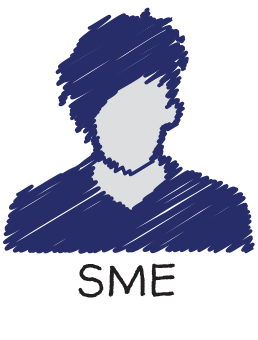 Subject Matter Experts are typically shared across multiple teams, and support them in a specific domain. They weigh in on various ideas, help refine User Stories, and help test & verify that results are correct. SMEs should understand the overall business objective as well as the needs of the market and customers. They freely share their knowledge and need to be adept at managing their capacity as teams may pull them in multiple directions.
Subject Matter Experts are typically shared across multiple teams, and support them in a specific domain. They weigh in on various ideas, help refine User Stories, and help test & verify that results are correct. SMEs should understand the overall business objective as well as the needs of the market and customers. They freely share their knowledge and need to be adept at managing their capacity as teams may pull them in multiple directions.
- Values & Goals
- Understand how they contribute to the shared purpose
- Demonstrates commitment & responsibility
- Proactively acts & communicates
- Willing to learn & grow
- Product & Impact
- Empirical Observation of progress & improvement
- Configures the Agile tooling
- Promotes achievement mindset
- Leads by example
- Leadership & Culture
- Creates trust relationships
- - Safe, Collaborative environment
- - Accountability & Integrity
- Visibility & Transparency
- Motivates & inspires
- Helps team commit
- Mentors
- Markets & Environment
- Owns the process/methodology
- Clear Impediments
- Schedules & Facilitates meetings
- Improves flow
- Creates environment of success
- Integration of industry standards & future innovations
Stakeholder/Business Owner
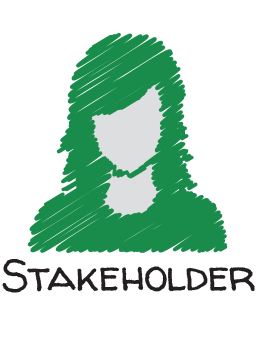 Stakeholders of a team are those who are greatly impacted by what the team is working on. This broad role ranges from key customers, people who consume the services provided, leaders, and even the sponsor for the project/product. Stakeholders should help create success metrics and set milestones, but their main contribution is to give feedback and influence the product as it's being developed. A good rule of thumb is to invite Stakeholders to all Sprint Reviews but let them know if there has not been enough functionality built for them to give valuable feedback, as it can sometimes take more than one sprint to implement features that bring value to them.
Stakeholders of a team are those who are greatly impacted by what the team is working on. This broad role ranges from key customers, people who consume the services provided, leaders, and even the sponsor for the project/product. Stakeholders should help create success metrics and set milestones, but their main contribution is to give feedback and influence the product as it's being developed. A good rule of thumb is to invite Stakeholders to all Sprint Reviews but let them know if there has not been enough functionality built for them to give valuable feedback, as it can sometimes take more than one sprint to implement features that bring value to them.
- Values & Goals
- Engaged in the Agile process
- Customer focused
- Clear of purpose & direction
- Value/Impact mindset
- Product & Impact
- Creates measurements for success
- Rapid decision making
- Attends Demos
- Attends Continuous Improvement events
- Leadership & Culture
- Partners with the Product Owner
- Gives the team directional feedback
- Trusts the team
- Markets & Environment
- Uses long feedback loops to course correct
- Stays ahead of the market
- Aligns with broader organizational objectives
Team
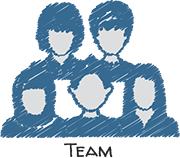 The Agile Team is the most important unit in any Agile organization. This is where Agile began, and got noticed due to the tremendous results that were seen when teams were empowered to take responsibility for their own success, direct their own planning and estimation, work at a sustainable pace, and strive for continuous improvement supported by transparency, regular feedback, and a supportive management and product team led by the Product Owner.
The Agile Team is the most important unit in any Agile organization. This is where Agile began, and got noticed due to the tremendous results that were seen when teams were empowered to take responsibility for their own success, direct their own planning and estimation, work at a sustainable pace, and strive for continuous improvement supported by transparency, regular feedback, and a supportive management and product team led by the Product Owner.
As Agile scales to the enterprise it is important to recognize that an enterprise is ultimately a large collection of teams, and that its success depends entirely on the degree to which teams are empowered, supported and aligned with clearly defined product, enterprise and architectural goals.
- Values & Goals
- Committed to the product vision
- Demonstrates commitment & responsibility
- Proactively acts & communicates
- Willing to learn & grow
- Challenges the status quo if appropriate
- Customer focused
- Product & Impact
- Delivers customer value
- Ensure Quality (avoid defects)
- Healthy team metrics
- Creates reusable functionality
- Leadership & Culture
- Shares responsibility towards ToT goal
- Embodies Team Culture
- Transparent, overcommunication
- Shares best practices
- Innovation & Growth culture
- Business & tech partnership
- Markets & Environment
- Follows/Trusts the processes & standards
- Ability to network with outside systems
- Ruthlessly eliminates waste
- Balances internal & external needs
- Automation focus



